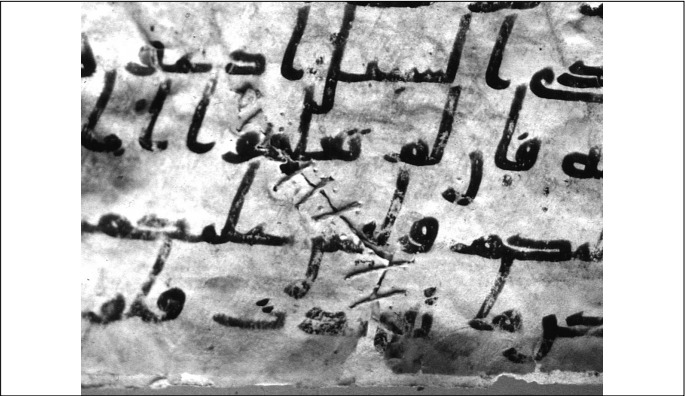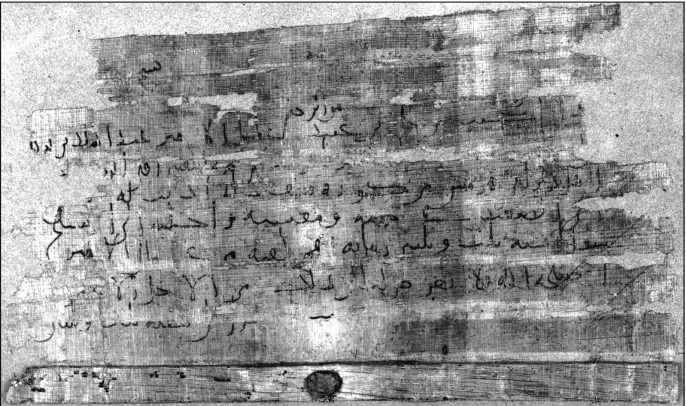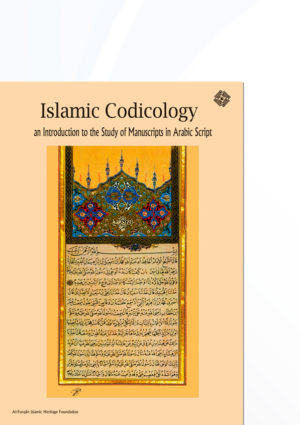François Déroche, with contributions by Annie Berthier, Marie-Geneviève Guesdon, Bernard Guineau, Francis Richard, Annie Vernay-Nouri, Jean Vezin, Muhammad Isa Waley

In the course of history mankind has used many materials - mineral, plant and animal - to write on. The following two chapters will be concerned only with those writing surfaces (papyrus, parchment and paper) employed in the Islamic world in manufacturing handwritten books in codex form.[1] These materials were also utilised for other aspects of book production, such as binding; those other uses will be discussed at greater length in the relevant chapters.
Papyrus
In the Arab and Islamic field, papyrus more readily brings to mind types of documents that do not belong to the sphere of codicology proper: letters, contracts, administrative documents, etc. In fact, though, only scattered remnants of manuscripts written on papyrus in Arabic script have survived the intervening centuries, and our knowledge of the role played by this material in the history of books in Arabic script (illus. 5.) remains scanty. Papyrus preserves traces of its vegetable origin since the fibres of the plant remain visible at the end of the manufacturing process, their two sides being distinguished respectively by whether the fibres run horizontally or vertically.
Origin
The word ‘papyrus’ denotes both a plant and the writing material made from it. Cyperus papyrus L. - to use its botanical name - grows wild in its original habitat, Egypt. During the first centuries of the Islamic period, it was also found in Palestine, Mesopotamia and Sicily.[2] In Arabic, it is designated by terms such as qirṭās, 𝓌araq al-qaṣab (‘leaf of reed’) and 𝓌araq al-bardī|al-abardī (‘leaf made of papyrus’).[3] The word ‘papyrus’, from which, paradoxically enough, the word ‘paper’ originates, is a loanword from the Latin papyrus or the Greek πάπυ𝘱οϛ, both derived from the Coptic pa-p-ouros.
Historical background
Used as a writing medium from around 3000 BCE,[4] papyrus was known and employed in Arabia well before Islam.[5] With the meteoric rise of the Islamic empire in the first/seventh century came the conquest of areas in which grows the plant whose stems can be fashioned into papyrus. Offices and private individuals, civil servants and scholars alike used the material for various purposes such as letters, books, contracts, and tax registers. Papyrus in use until around the mid-fourth/tenth century, by which time competition from paper became overwhelming,[6] papyrus manufacture practically dying out by the fifth/eleventh century.[7] To judge by the repeated demands issued by the Caliph ‘Umar II (reigned 99/7ɪ7-ɪ0ɪ/720) that sought to encourage economies in government offices,[8] it must have been a relatively expensive material. The same conclusion emerges from the study of surviving papyrus prices,[9] and is further corroborated by the manner in which every single part of a sheet of papyrus has sometimes been gradually encroached upon by writing until eventually it is completely covered with script in every direction.[10]
The Manufacture of Papyrus
A description of papyrus production by Abū l-‘Abbās al-Nabātī (died 637/ɪ239) survives in an Arab source of the seventh/thirteenth century, the Ɉāmi‘ li-mufraḍāt al-ad𝓌iya 𝓌a-l-aghdhiya by Ibn al-Bayṭār (died 646/ɪ248). Al-Nabātī possessed no direct knowledge of the manufacturing process which had in fact died out by the time this passage was written: ‘The Egyptians used in former times to split the stalk of the papyrus into two parts, cut [the pulp obtained thereby] into strips, put them [crosswise, in two layers] on an even pad made of wood; spread on them a size (luzūja) made from the seeds of the blue lotus (Nymphӕa coerulea Sav.) mixed with water; having left the strips to dry completely, they would then beat them thoroughly with a piece of wood resembling a small mallet until they got an even, solid sheet.ʼ[11] Apart from the use of size, this text rather closely parallels the classic account given by Pliny the Elder. ‘The process of making paper [i.e. sheets] from papyrus is to split it with a needle into very thin strips made as broad as possible, the best quality being in the centre of the plant, and so on in the order of its splitting up. [...] paper [sheets] of all kinds are woven on a board moistened with water from the Nile, muddy liquid supplying the effect of glue. First an upright layer is smeared onto the table, using the full length of papyrus available after the trimmings have been cut off at both ends, and afterwards cross-strips complete the latticework. The next step is to press it in presses, and the sheets are dried in the sun and then joined together.[12] The foregoing description is relatively clear, except with regard to the initial stages of the operation when the leaves are cut up. Papyrologists understand the texts to mean that the stem, triangular in crosssection, is first divided into segments and then split into two halves that are sliced into strips from the centre of the stem outwards, parallel either to one of its sides or else to the incision.
Adolf Grohmann has countered this view with the following observation: ‘It has long been believed that the pieces of pith could be separated merely by being slit longitudinally. Microscopic examination has demonstrated, however, that this was not the case. For if the strips separated by simple longitudinal cuts had been laid side by side, the packs of cells in the pith which to the naked eye look like fibres, should appear spread over two zones, tighter towards the bark but looser in the central section. Consequently, where the strips of pith touch, tight packs of vessels should appear, whereas they should remain sparser towards the middle. But papyri themselves do not in fact demonstrate such a variation. The quantity of fibres is as homogeneous under the microscope as it is to the naked eye.ʼ[13] Grohmann goes on to offer a different interpretation of the cutting process: ‘After removing the bark [of the papyrus], the lamellae comprising the stem would be separated with the aid of a sharp point. Another method consisted in [...] attaching a thin blade to a horizontal support and rotating the pieces of pith around their axis, pushing them against this plane like device. According to whether the strips of pith, whose breadth varies between ɪ.5 and 8 cm, were extracted from the bark area or from the centre, the variety extracted would be thin or thick, or even extremely thin.ʼ[14]
While the first step in manufacture has, as we have seen, given rise to divergent interpretations, the nature of the subsequent phases, on the other hand, is relatively unambiguous. The strips of pulp were laid out side by side on a flat surface; next, perpendicular to the axis of this first layer was placed a second series of strips, also side by side. Then a preparation designed to bind the various ingredients together might be spread over the sheet[15] and then pressed, before being smoothed out (an operation for which, according to Pliny, a tooth or a shell might be employed).[16] The rectangular pieces thus obtained (Greek, kollémata, the plural of kollèma - ĸόλλημα) commonly measured between 20 and 30 cm wide and from 30 to 40 cm long, but the width tended to increase over time; the minimum and maximum dimensions given by Grohmann vary between ɪ2.7 and 37 cm. for width and between 30 and 58 cm for length.[17] The sheets were then sorted according to quality, and twenty of them were glued end to end with a slight overlap (approximately 2 cm.), care being exercised to lay the fibres in one and the same direction; the joints were then smoothed down so that they would offer no resistance to the passage of the reed pen. The strip thus obtained was then rolled.[18]
By the end of the process, the papyrus appeared as a roll in which the horizontal fibres parallel to its length faced inwards. In accordance with the practice in antiquity of copying books as υolumina, this was the first side to be written on, and thus constitutes what might be referred to as the ‘rectoʼ. On the outside of the roll, the fibres lay vertically: hence this side was in effect a ‘versoʼ, and was generally used second. The scribe would copy documents perpendicularly to the fibres of the recto.[19]
The protocol
A strip of poorer quality whose fibres lay perpendicular to those of the rest of the sheets[20] would then be stuck to the head of the roll known as the protocol (from the Greek prôtokollon - πρωτόĸλλov), whose function was to protect the roll. As was the custom in Byzantine tradition, this initial sheet bore an inscription also known by the term ‘protocolʼ. During the Arab period, this text was initially written in Greek, and then in Arabic and Greek from 74 or 75/693-694 or 694-695, and finally in Arabic alone.[21] After the basmala, the protocol would contain various religious formulae - such as the shahāda, the taṣliya (invocation of blessings on the Prophet) - or some verses from the Qurʼān, together with the name of the reigning caliph and, as the case might be, that of the governor of Egypt, the director of finance for the province or other senior officials. Authorities differ as to whether this inscription corresponded to a tax levied or to a makerʼs mark.[22] The script employed for the protocol is of a particular type that might perhaps have been executed with a brush; in later times, combinations of inks of various colours (red and green, more rarely blue) were used to copy this text.
The use of papyrus in Arabic manuscripts
In the Islamic period, makers continued to prepare papyrus as they had done in ancient times, sticking the kollèmata together to obtain a roll: this manner of proceeding explains why several ways of using papyrus are found in manuscripts. Too few manuscripts survive to allow any major trends to be extrapolated; only a few necessarily brief observations can be made.
First of all, the whole roll can be used as it is, or else lengthened by sticking several rolls end to end, as required. The result could be a strip of some considerable length: indeed, two surviving letters exceed two meters in length;[23] but, according to one source,[24] the total length might reach nearly fifteen. Copyists could then lay out the lines of writing parallel to the length of the roll and set out their texts in columns side by side, a solution that corresponded to the shape of the book in antiquity (the υolumen), a form eventually supplanted by the codex in the first centuries of the common era (henceforth CE). In the Islamic world, so far as we are aware, the υolumen itself is not attested. If, on the other hand, the copyist wrote at right angles to the length of the roll, the term is rotulus. The rotulus - and more especially when made from papyrus - was employed during the first centuries of the Hijra, in particular for notes;[25] one example is the compilation of Traditions made by ‘Abd Allāh b. Lahī‘a preserved at Heidelberg (P. Schott-Reinhardt Inv. Ar. 50-53).[26]
Another way of handling papyrus consisted in progressively dividing it into pieces of variable size according to need. Sources indicate that the roll could be sold not only whole but also in smaller units, the most current - corresponding to one-sixth of a roll-being known as a ṭūmār (from the Greek tomarion-τoμάρıov)[27]. As will be shown below,[28] several pieces of the same size could be cut, superposed, and then folded in the middle so as to comprise a gathering (kurrāsa).[29] Papyrus codices are in fact attested in the Islamic world from earliest times, which is hardly surprising since their use was already well established in areas taken over by Muslim conquerors. Some documentary codices in Egypt listed by Jean Gascou have been dated prior to the ‘Abbāsid period.[30] Several of these, dating from between 699-705 and 7ɪ6-72ɪ CE, are made up from leaves (i.e. single bifolium) folded into two;[31] another, from after 7ɪ6-7ɪ7, comprises a single gathering. It is thus advisable to treat with a degree of scepticism the theory voiced by several Arab authors of a shift from scroll to unbound quire (daftar) within the administration of the empire during the reign of the first ‘Abbāsid caliph, al-Saffāḥ (reigned: 749-754).[32] In this connection, it would undoubtedly be interesting to re-examine the history of the use of the daftar in the early Umayyad and ‘Abbāsid administrations.
Now, the existence of the documentary codices mentioned above makes it possible to assert that, for papyrus - contrary to what has sometimes been argued[33] - the codex form was employed very early in the Islamic period. Admittedly, the majority of literary papyri subsist in a fragmentary state and provide only an incomplete picture of the use of the material. Nevertheless, these survivals, which include a certain number of bifolia in reasonably good condition, seem to confirm the conclusion that the codex was indeed the dominant form.[34] Two of these papyrus manuscripts are better preserved and might perhaps provide more precise data: one is preserved in Heidelberg (P. Schott-Rheinhardt Arab. 23, dated to 229/843-844)[35], the other in Cairo (Dār al-Kutub, Ḥadīth 2ɪ23, before 276/889-890).[36] According to Nabia Abbott, there was a preference for square formats.[37]
Physical examination of papyrus

Physical examination should concern itself with the direction in which the fibres of the papyrus run (illus. 5). As has been noted, the interior face of the roll is conventionally called the recto, the outside being known as the verso. Papyrologists specialising in the Classical world extend this terminology to pieces cut from the whole, the recto bearing written lines parallel to fibres of the material. Ambiguities arise in the case of a codex, however, since the terms ‘rectoʼ and ‘versoʼ can apply to the sheet itself, quite independently of the direction in which the script runs with respect to the fibres. A number of authors have therefore advocated indicating the horizontal fibres by the sign
→, while for the other side the symbol ↑ shows that the fibres lie vertically.[38] The occasional presence of joins in the middle of a sheet should also be noted.
Conservation and re-use...
*The remainder of this article is exclusively available in the printed version of the related book. The book is available in both electronic and printed formats within Our Publications in the following link:
http://doi.org/10.56656/100099
[1] Other materials have also been used to make manuscripts in codex form, if only sporadically. One case is represented by a Qurʼān extract copied on wood, published by N. Abbott (‘An Arabic-Persian wooden Ḳurʼânic manuscript from the royal library of Shah Ḥusain Ṣafawī I, 1105-35 H.ʼ, Ars Islamica 5 [1938], pp. 89-94).
[2] Grohmann, AP I, pp. 67-69. Pliny the Elder already noted (Natural History, XIII, 11, 73) that papyrus grew not only in Egypt, but also in Mesopotamia and in Syria. See also the references in note 4.
[3] Gacek, AMT, pp. 11 and 116.
[4] See W. Schubart, s.v. ‘Papyrusʼ, Paulys Realenzyclopädie der classischen Altertums𝓌iseissenschaft, XVIII/3, col. 1116-1118; also K. Maresch, s.v. ‘Papyrusʼ, Lexicon des Mittelalters, vol. VI, col. 1693-1695. For the Islamic domain, reference can be made to Grohmann, AP I, pp. 66-93, and to G. Khan, Bills, letters and deeds, p. 11-22 and ‘Arabic papyriʼ, in Codicology, pp. 1-16.
[5] A number of references to papyrus appear in pre-Islamic Arabic poetry: see Grohmann, AP I, pp. 68 and 70. The Qurʼān also mentions papyrus (e-g. VI: 7 and 91, etc.).
[6] Grohmann, AP I, p. 73. This author maintains that the most recent datable papyrus is from 480/1087. Later documents appear in editions of Arab papyri, a situation that can be explained by the habit among specialists in Arab papyrology of grouping together documents copied on various supports (paper, parchment, etc.) into a single category as ‘papyrusʼ.
[7] R. Sellheim, EI2 V, p. 171, s.v. ‘Ḳirṭāsʼ.
[8] Al-Qalqashandī, Kitāb Ṣubḥ al-a‘shā fī ṣinā‘at al-inshāʼ, vol III (Cairo, n.d.), p. 49.
[9] Grohmann, AP I, pp. 92-93.
[10] Grohmann, AP I, p. 74. Letters survive in which the receiver has written a reply on the verso, and even in the spaces left empty on the recto. Y. Rāghib (‘Lʼécriture des papyrus arabes aux premiers siècles de lʼIslamʼ, REMMM 58 [1990], p. 22) points out that government offices themselves had no qualms about employing used leaves that were surplus to requirements
[11] Ɉāmi‘-li-mu fradāt, vol. I, Beirut, 1412/1992, p. 119, 1. 17 sq.; Grohmann, API, p. 76; for a translation of the text see R. Sellheim, loc. cit.
[12] Pliny the Elder, Natural History, XIII, xxiii, 74-77; vol. 4, ed. H. Rackham (Cambridge, Mass. and London, 1945), pp. 143-145.
[13] Grohmann, ‘Aperçu de papyrologie arabeʼ, Études de papyrologie 1 (1932), p. 31. His critique is taken up in AP I, p. 77.
[14] Op. cit., p. 30. More recently, Grohmann has expanded on the hypothesis of ‘peelingʼ of the papyrus stalk. He bases his argument this time on the techniques employed in China for making rice paper:after making an incision in a piece of Aralia tetrapanax papyrifera laid in front of him, the workman holds the knife firmly in his hand and slowly and steadily rotates the pulp against the blade of the knife, thereby extracting the long (2 to 3 foot) leaves in a spiralling movement (AP I, pp. 77-78). The results of microscopic examination of papyrus are equally important in this connection: see A. Wallert, B. M. Moeliono and J. D. Kruijer, ‘Mikroskopische Untersuchungen von Papyrus und Plinius, Hist. Naturalis XIII, 74-83ʼ, Zeitschrift für Papyrologie und Epigraphik 76 (1989), pp. 39-44.
[15] The use and even the existence of sizing is a matter of dispute: see Grohmann, AP I, pp. 78-79. It is questionable, however, whether that was really the desired effect. Pliny the Elder states that the leaves were indeed sized: ‘The common kind of paste for paper is made from fine flour of the best quality mixed with boiling water, with a very small sprinkle of vinegar [...] but a more careful process is to strain crumbs of leavened bread in boiling water, this method [...] produces a paper softer even than linenʼ (Pliny the Elder, Natural History, XIII, xxvi, 82). This manner of proceeding is reminiscent of the kinds of preparations employed in papermaking (see below).
[16] Pliny, loc. cit.
[17] Grohmann, AP I, p. 87.
[18] This clue as to the number of leaves used to compose a roll derives from Pliny the Elder. The process seems to have endured through the Islamic period (q.v. A. Grohmann, AP I, p. 89).
[19] Khan, op. cit, in Codicology, p. 17 and 18 and fig. 3 b.
[20] Grohmann, AP I, p. 88.
[21] Grohmann (AP I, p. 82) notes the use of Arabic alongside that of Greek in the reign of Mu‘āwiya (reigned 41-60/661-680), and hence at an earlier date than that generally accepted as marking the introduction of Arabic into the work of the administrative offices, i.e. in the reign of ‘Abd al-Malik, in 74 or 75/693-694 or 694-695 (see for example G. Khan, op. cit., in Codicology, p. 14).
[22] Grohmann, AP I, p. 80 sq.
[23] Heidelberg Institut für Papyrologie MS. Inv. PSR 3-7 measures 2.31 m. (C. H. Becker, Papyri Schott-Reinhardt, I, in Veröffentlichungen aus der Heidelberger Papyrus-Sammlung, vol. III [Heidelberg, 1906], pp. 68-76, no. III); a letter in the collection in the Museum of Islamic Art in Cairo is 2.4 m. in length (M. Hinds and H. Sakkout, ‘A letter from the governor of Egypt to the king of Nubia and Muqurra concerning Egyptian-Nubian relations in 141/758ʼ, in W. al-Qadi (ed.), Studia Arabica et Islamica: Festschrift for Iḥsān ‘Abbās [Beirut, 1981], pp. 209-229).
[24] Cited by Rāghib, op. cit., p. 20 and n. 29.
[25] N. Abbott, Studies in Arabic literary papyri, vol. II, Qurʼāntic commentary and tradition [Oriental Institute Publications, 76] (Chicago, 1967), pp. 57-59, contains a lengthy discussion of the sometimes long rolls in which traditional records were kept; reference may also be made to the chapter on ‘The Quires of a codexʼ.
[26] R. G. Khoury, ‘Abdallāh ibn Lahīʼa (97-1741715-790), juge et grand maître de lʼécole éryptienne [Codices arabici antiqui, 4] (Wiesbaden, 1986), p. 232.
[27] See Gacek, AMT, p. 95. The word can also designate ‘leafʼ, ‘pageʼ and ‘letterʼ. The ṭūmār can also be divided into sections: Grohmann mentions onethird parts of a ṭūmār, i.e. 1/18 of a roll (AP I, p. 91).
[28] See also the chapter on The ‘Quires of a codexʼ.
[29] Grohmann (AP I, p. 75) raises this possibility, but is obviously thinking of administrative records rather than of codices. For kurrāsa, see Gacek, AMT, p. 124.
[30] ‘Les codices documentaires égyptiensʼ, in A. Blanchard (ed.), Les Débuts du codex, [Bibliologia, 9] (Turnhout, 1989), pp. 100-101.
[31] Ibid. and p. 79, see also chapter 3, infra.
[32] Sellheim, op. cit.
[33] See for example Sellheim, loc. cit.; also Gacek, AMT, p. 47.
[34] For an example of a bifolium, see N. Abbott, op. cit., pl. I. The relationship between codex and gathering is treated at greater length in Chapter 3, infra.
[35] R. G. Khoury, Wahb ibn Munabbih, 2 vol. (Wiesbaden, 1972).
[36] J. David-Weill, Le Djâmi‘ dʼIbn Wahb, 3 vol. (Cairo, 1939-1948).
[37] Abbott, op. cit., p. 2 and docs. 4 and 6.
[38] E. G. Turner, ‘Recto and versoʼ, ɈEA 40 (1954), pp. 102-106; O. Montevecchi, La Papirologia, p. 15.
| Source note: This article was published in the following book: Islamic Codicology: An Introduction to the Study of Manuscripts in Arabic Script _ English version, 2005, Al-Furqan Islamic Heritage Foundation, London, UK, pp. 25-48. |


